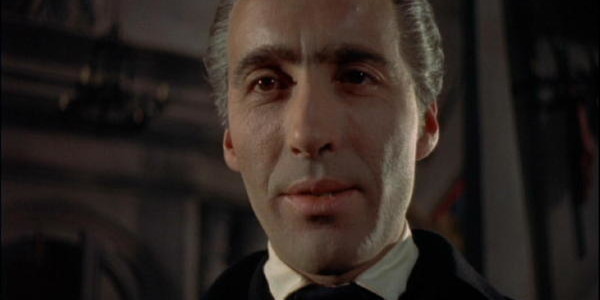Dracula is the ultimate subversion of Victorian society. He exists solely to undermine the established order, to violate every taboo, and to whisk proper Victorian ladies away from their fathers and husbands and lead them into an eternity of bloodlust and deviant sexuality. This sexuality was integral to the success of Hammer’s 1958 adaptation of Bram Stoker’s classic Gothic novel and the sequels that followed over the next fifteen years. Audience members – predominantly, though certainly not exclusively, women – lived vicariously through the women onscreen who opened their bedroom windows and awaited their nightly visits from Christopher Lee’s tall, dark, and undeniably sexy Count with a thrilling combination of fear and excitement.
To say that the vampire’s bite is a sexual act would be to state the obvious. It’s a direct perversion of penetrative intercourse and heterosexual procreation, and because vampiric sexuality subverts this limited Victorian definition of “acceptable” sexuality, it is inherently queer. Dracula feeds on both women and men, but it’s through vampire women that the queerness of vampirism is made most explicit. Free of both external and internalized sexual repression, these women often immediately turn to their closest female friend as their first victim.
In BRIDES OF DRACULA (1960), Gina promises her friend, “my darling Marianne,” that the two of them can live together in a polyamorous relationship with the film’s Dracula stand-in Baron Meinster. She approaches the other woman with intent to share her newfound sexuality, saying, “put your arms around me, please, I want to kiss you.” Similarly, in DRACULA: PRINCE OF DARKNESS (1966), Helen approaches her sister-in-law Diana with arms outstretched; when Diana demands to know where her husband is, Helen answers, “you don’t need Charles.” The threat that Dracula poses is made even more dangerous by the idea that women might not only be open to the deviant sexuality he offers, but that they might spread it to other women.

In this vein, Dracula might seem like a liberating force, freeing sexually repressed women from the confines of an oppressive society. TASTE THE BLOOD OF DRACULA (1970) examines this idea more directly than any other film in the franchise and confronts the hypocrisy of Victorian patriarchy. Alice’s budding sexuality is violently stamped out by her abusive father, who berates her and calls her a “harlot” for talking to her boyfriend at church and beats her for sneaking out of the house – all while he spends his drunken evenings at a local brothel. The film strips away the “façade of respectability” this man and those like him uphold. His abuse leads Alice right to Dracula, through whom she literally smashes the patriarchy by bashing her father’s head in with a shovel. She then recruits her best friend Lucy and the two of them gleefully murder her father as well.
However, the film also exposes the limits of Dracula’s so-called liberation: to him Alice and Lucy are merely means to an end, and they are discarded as soon as he’s finished with them.
While the unbound sexuality he offers is certainly appealing, the truth is that the women who join Dracula are simply trading one patriarchal structure for another. They are no more free, equal, or valued than they were before. Any romantic notions found in many other Dracula adaptations are completely absent here; none of the women Dracula chooses are special to him.
Vampire women are confined both figuratively and literally; they are not free to choose their own victims nor can they leave Dracula’s castle without permission. Both Valerie Gaunt’s nameless vampire in HORROR OF DRACULA (1958) and Tania in SCARS OF DRACULA (1970) appeal to a mortal man who comes to the castle for help, claiming that they are a prisoner and want to escape. While in both cases this is almost certainly a ruse to gain access to the unfortunate fellow’s jugular (and perhaps an appeal to preconceived notions of femininity and victimhood), Dracula’s violent reaction suggests there is some truth to it. Both women are punished for their defiance and swiftly replaced by another.

After SCARS OF DRACULA, Hammer moved the Count from the Victorian era to 1970s London for DRACULA A.D. 1972 (1972) and THE SATANIC RITES OF DRACULA (1973). This move drastically changed the dynamic between Dracula and the films’ women. The 1970s were a time of sexual liberation and bucking tradition. Certainly, there was plenty of progress yet to be made in terms of women’s rights, but women of the 70s enjoyed a level of freedom in all aspects of their lives that their Victorian counterparts could never have dreamed of. If Dracula’s appeal depends on representing the antithesis of an oppressive society, how can he compete with a culture that is already challenging that oppression?
The result is that, while his sexuality still holds a certain allure, Dracula is no longer the more exciting option. Without the illusion of sexual liberation, all that’s left is his own brand of patriarchal oppression. His methods shift accordingly; in DRACULA A.D 1972, he simply kills the women he feeds on instead of turning them as he did in previous films. And in THE SATANIC RITES OF DRACULA, the vampire women are literal prisoners, chained in a basement where there’s no chance they might try to seek their own victims.
These later films fully expose the idea of women achieving sexual liberation through Dracula as a mirage. Still, the Count’s allure persists. It will never not be satisfying to watch him and his vampire women infiltrate Victorian society, perhaps because many ideas about sexuality and womanhood that flourished during the Victorian era unfortunately linger today. In a culture that is still steadfastly heteropatriarchal, that still takes every opportunity to police women’s bodies and dictate our sexuality, Dracula’s deviant nature will always be relevant – and we will always be tempted to open our bedroom windows just enough to invite him in.


No Comments